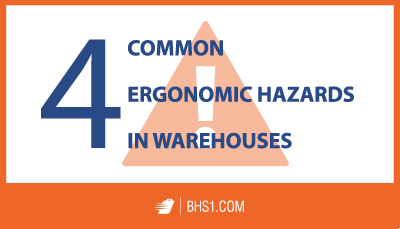We use cookies to make your experience better. To comply with the new e-Privacy directive, we need to ask for your consent to set the cookies. Learn more.
4 Common Ergonomic Hazards in Warehouses
Injuries have a big impact on warehouse productivity and profitability, and every warehouse could stand to address common safety hazards. The good news is that warehouse managers can reduce the chance of an on-the-job injury by identifying the most common injury risks and addressing them with training or ergonomic equipment.
Safety committees can help identify major risks for your operation.
Creating a safety committee can help gather input from many different points of view. These committees should include staff from various areas, including floor workers, shift supervisors, and department managers.
For smaller operations, a safety meeting with all staff could replace the safety committee. However an operation manager has to arrange it, crucial safety information must be shared with staff. If you're just getting started with a safety overhaul, here are some common issues to watch for. 
-
Personnel using poor lifting technique.
Poor lifting technique is one of the costliest causes of injuries in warehouses. Even when lifting injuries aren't severe, they reduce productivity.
The first step to reducing poor lifting technique is to have proper training. All employees should have training and managers should document it.
Investing in powered equipment can also help employees protect themselves. When a load is too large to be manually carried or lifted, employees should use machines like bin dumpers and lift tables. When powered equipment is unavailable, lifting a load with a coworker can reduce the possibility of injury.
-
Employees reaching and twisting during packing.
Even if you eliminate bending entirely, you're still left with potential injuries from reaching and twisting. These types of injuries seem less severe, but they can be just as costly.
Using tilt tables to reposition loads is a great way to reduce strains and injuries associated with reaching and twisting. Self-leveling tables with rotating tops help workers reposition pallets so that reaching is kept to a minimum.
-
Not guarding falling hazards.
Falling injuries are among the most common and the most fatal. Managers should take precautions to guard against these deadly accidents.
Forklift work platforms can minimize risks for those doing overhead tasks, like changing light bulbs. Structural barrier rails can alert pedestrians and forklift drivers of dangerous ledges and prevent accidents from occurring. Warehouse managers must identify locations where falls are most likely and take action before an accident happens.
-
Cluttered floors and aisles.
Tripping and slipping cause a great deal of warehouse injuries. Maintaining tidy aisles and floors is a good first step to avoiding these types of injuries.
Staff should stack empty pallets and keep inventory in designated spaces out of pathways. Wet spots on floors should be dried immediately to eliminate the slipping hazard they pose. Any staff noticing a tripping or slipping hazard should correct it and bring it to the attention of the safety committee if it is a chronic problem.
Safety is a group effort.
A safety committee or safety meetings can help inform warehouse managers of potential hazards. Managers should use that information to address the most significant dangers.
Even when employers buy new equipment and train their workers well, staff themselves must continually strive to maintain a safe workplace. Doing so will make every job more productive, profitable, and happy.
References:
Edwards, John. "Warehouse Safety: It's No Accident." InboundLogistics. Thomas Publishing Company, 15 May 2007. Web. 17 July 2017.
"Materials Handling and Storage." OSHA. Occupational Safety and health Administration, United States Department of Labor, 2002. PDF. 17 July 2017.
Ware, Brandy and Jeffrey Fernandez. "Warehouse Ergonomics/Tips and Techniques To Decrease Injury Risk." EHSToday. Penton, 7 Mar. 2014. Web. 17 July 2017.
"Worker Safety Series: Warehousing." OSHA. Occupational Safety and Health Administration, United States Department of Labor, n.d. PDF. 17 July 2017.
